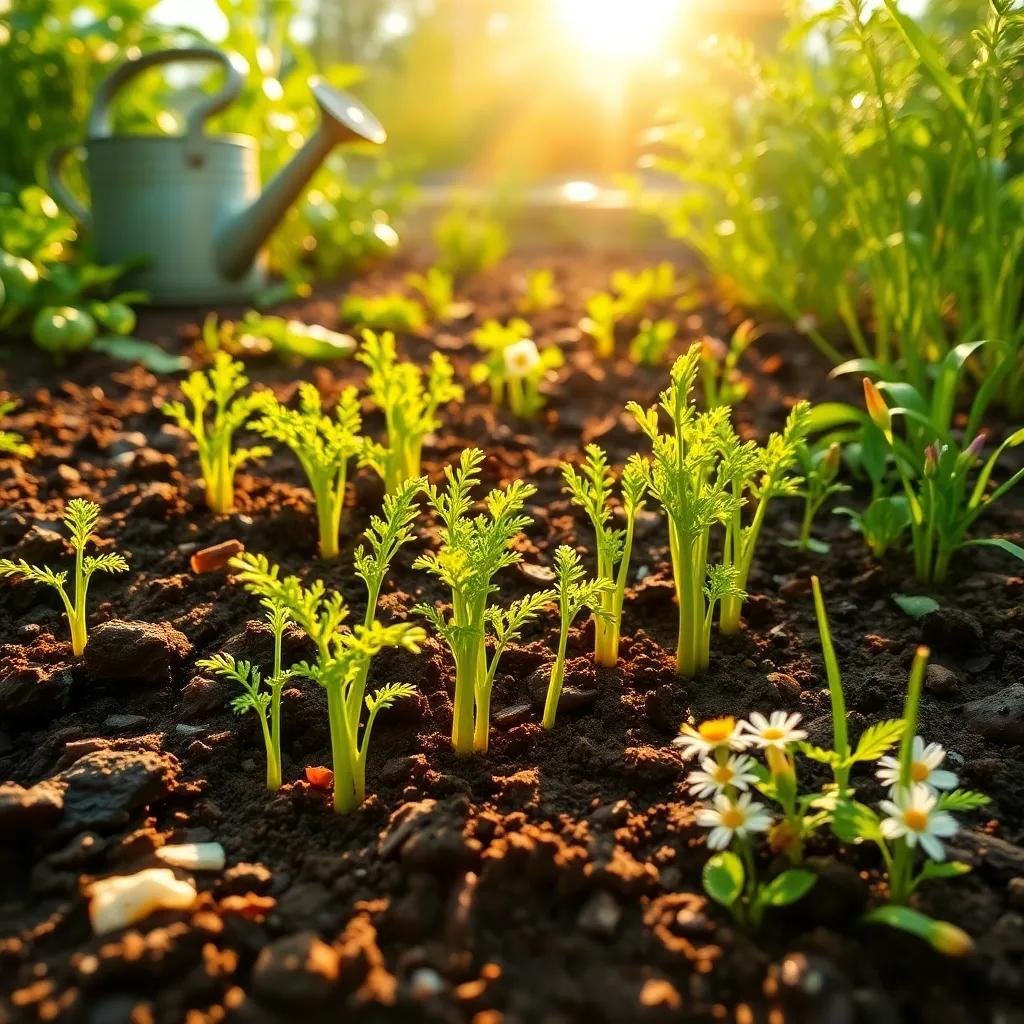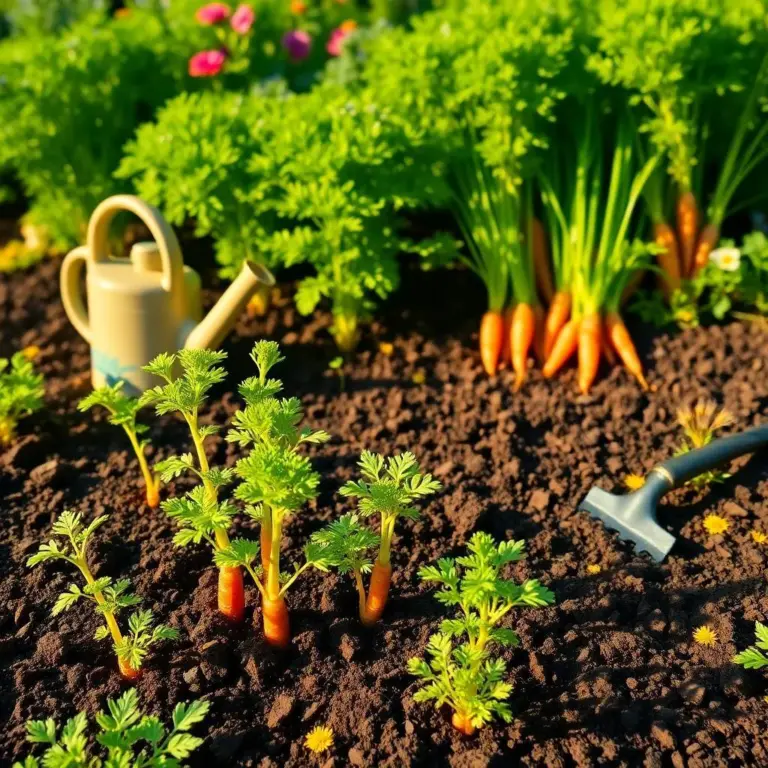Growing carrots from seeds is a fun and rewarding journey that anyone can enjoy! From tiny seeds to delicious, crunchy roots, each stage of growth is exciting and full of surprises. Ready to dig in and discover the secrets to growing your very own carrots? Let’s get started—your garden is waiting for those tasty veggies!
Seed Germination: Timelines and Requirements for Carrots
Getting those carrot seeds to sprout is the first exciting step in your gardening adventure! But how long does it take for these little packets of potential to wake up? Generally, carrot seeds germinate within 7 to 21 days. Yep, that’s right! A little patience goes a long way when growing your own veggies.
To help those seeds along, you’ll need to create the perfect cozy home for them. Here are some key factors to keep in mind:
- Soil Temperature: Carrots like it cool—ideally between 60°F (15°C) and 75°F (24°C). Too hot, and they might just sulk! If it’s too cold, they may take longer to sprout.
- Moisture: Keep the soil moist but not soggy. Too much water can drown those little seeds, while too little can make them shrivel up. I usually water gently to avoid washing away the seeds!
- Soil Quality: Loose, well-drained soil is a must! If my soil is too compact, those brave little roots might get stuck. Before planting, I like to mix in organic matter like compost to create a happy environment.
So, you’ve prepared the soil and planted the seeds—now it’s time to wait! Don’t be discouraged if you don’t see sprouts right away. It might take time, but soon enough, you’ll see tiny green shoots poking their heads through the soil. It’s like a little green parade just for you!
Seedling Stage: Care for Young Carrot Plants
Ah, the seedling stage! This is when carrot plants really start to show their personalities! After about 2 to 4 weeks of germination, those little green tops will emerge, and they’ll need your love and attention to flourish!
Here’s how to give your seedlings the best start:
- Light, Light, Light! Carrots love the sun! Aim for at least 6-8 hours of direct sunlight each day. If your garden isn’t quite sunny enough, consider moving your pots or using grow lights.
- Watering Wisely: Young plants need moisture but don’t like to be swimming! Water deeply a couple of times a week, letting the top of the soil dry out in between. If it feels like a sponge, then it’s just right!
- Thinning Out: If you’ve planted your seeds closely, you might need to do some “gardening yoga” and thin out those seedlings. Aim for 2 to 3 inches between each plant so they can grow happily without stepping on each other’s toes!
- Weed Control: Weeds can be pesky roommates! Keep an eye on your carrot patch and pull out any weeds that try to crash the party. They’ll compete for sunshine, water, and nutrients, so it’s best to keep them at bay.
As your seedlings grow strong and healthy, they’ll develop little true leaves, which are vital for their growth. Give them time, and soon they’ll be ready to move on to the next exciting stage of their journey—growing those delicious carrots we’re all waiting for! Happy gardening!

Vegetative Stage: Promoting Leaf Growth and Vitality
Welcome to the vegetative stage of carrot growth—it’s like the teenage years for our little plants! During this phase, which lasts around 4 to 6 weeks, the focus shifts to growing strong, healthy leaves. And let me tell you, those leaves are super important! They’re like solar panels, soaking up sunlight so our carrots can grow big and delicious.
Here are some tips to help your carrots thrive during this exciting stage:
- Sunshine Galore: Carrots love sunlight! Make sure they get at least 6 to 8 hours of direct light each day. If your garden is a bit shady, consider moving them or using grow lights to boost their spirits.
- Water Smartly: Consistent watering is key. The soil should be kept evenly moist but not drenched! I usually water deeply about once or twice a week. Just remember, carrots have a shallow root system, so regular watering helps them dig deep into the soil.
- Give Them Space: Proper spacing is critical. Thin out seedlings to about 2 to 3 inches apart. This helps prevent overcrowding and allows each plant to soak up all the nutrients and sunlight it needs.
- Nutritious Feeding: To keep those leaves growing, consider using a balanced fertilizer or some organic compost. Follow the package guidelines, and don’t go overboard! Too much fertilizer can lead to excessive foliage, and we want to grow carrots, not just leaves!
As your carrot plants grow, keep an eye out for any pests or diseases. Early detection can save the day! With proper care, your carrot plants will have a sturdy vegetative phase, setting the stage for the next exciting chapter: root development!
Root Development: Ensuring Healthy Carrot Growth
Ah, the moment we’ve all been waiting for: the root development stage! This is where the magic happens and our carrots start growing those long, lovely taproots we all crave. This phase typically lasts for several weeks and is all about nurturing those roots to produce delicious, juicy carrots.
Here’s how to give your carrot roots the best chance to flourish:
- Soil Matters: Carrots need loose, well-drained soil to grow properly. If your soil is compacted, these roots may struggle to grow straight. Prep your soil by tilling it well and adding organic matter like compost or well-rotted manure.
- Consistent Moisture: Keeping the soil moisture steady is key here. Carrots prefer to stay evenly moist, so I water them deeply about once or twice a week. However, avoid puddles! Too much water can cause rot—yikes!
- Spacing for Success: Just like in the vegetative stage, proper spacing is essential. Crowding can lead to funny-shaped carrots, and nobody wants that! Thin out the seedlings to give each carrot enough room to grow. Aim for at least 2 to 3 inches apart.
- Nutrient Boost: Phosphorus plays a big role in rooting. Before planting, mix a phosphorus-rich fertilizer into the soil. Bone meal or rock phosphate works wonders for encouraging healthy root growth!
As those roots begin to thicken and stretch below the surface, keep an eye on your plants. Watch for signs of stress, like wilting leaves, which may signal they need more water or nutrients. With a little TLC, you’ll soon have a garden full of healthy carrots ready for harvesting!
Harvesting Carrots: Timing and Techniques for Best Results
Harvest time is the grand finale of your gardening adventure! After all that nurturing, it’s time to enjoy the fruits of your labor—delicious, homegrown carrots! Knowing when and how to harvest is key to maximizing flavor and quality.
Let’s dive into the nitty-gritty of harvesting your carrots:
- Timing is Everything: Carrots typically take about 70 to 80 days from seed planting to reach maturity. However, it can vary based on the variety. I always check the diameter of the roots; they should be around 1/2 to 3/4 inches thick for the best taste!
- Gentle Diggers: When it’s time to harvest, I like to loosen the soil around the carrot with a garden fork or trowel first. This reduces damage when pulling them out. Just be gentle—no one likes broken carrots!
- Pulling Them Up: Grasp the foliage of the carrot, and give it a gentle tug. If it resists, use your fork to loosen it further. With a little perseverance, those tasty roots will pop right out of the ground!
- Storing Your Harvest: Once harvested, brush off excess soil but avoid washing them until you’re ready to eat. Store your carrots in a cool, dark place to keep them fresh for longer.
Harvesting carrots is like unwrapping a present—you never know exactly what shape or size they’ll be! Regardless of their form, there’s nothing quite like the satisfaction of enjoying the fruits of your labor. Bon appétit!

